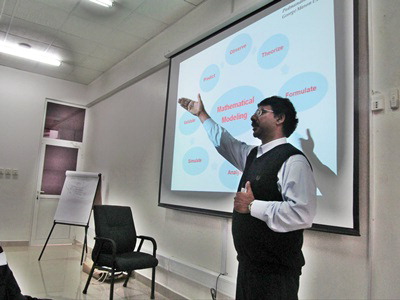|
|
Cycle 2 (2012 Deadline)
Computational Mathematics, Modeling and Analysis of Biological, Bio-inspired and Engineering Systems PIs: Madundo Mtambo and Burton Mwamila (Nelson Mandela African Institution of Science and Technology) U.S. Partner: Padmanabhan Seshaiyer (George Mason University)
Project Dates: August 2013 to September 2014 
U.S. partner Padmanabhan Seshaiyer leads a talk during the Mathematical Modeling Summer Institute, held September 2013 at the Nelson Mandela African Institution of Science & Technology (Photo courtesy Drs. Mtambo and Mwamila) |
Project Overview
East Africa is greatly in need of capacity building for educational excellence in science, technology, engineering, and mathematics (STEM). The ultimate goal of this PEER project was to promote capacity building by creating a broad network of knowledgeable scientists and researchers who can collaborate to tackle some of the most urgent problems in food security, environment, education, water and global health affecting Tanzania and neighboring countries.
The PEER grantees organized a three-week course on multidisciplinary applications of mathematics for members of the mathematical, biological and engineering community in Tanzania, especially early career researchers, graduate and post-graduate students. The goal was to create much-needed awareness on how to pursue multidisciplinary real-world problem-solving using STEM. The project was modeled after and built upon a successful National Science Foundation Research Experiences for Undergraduates program that the U.S. partner directed. In particular, the selected participants had the opportunity to learn about new content, software, and tools and apply them to solve real-world problems.
Final Summary of Project Activities 
Co-PI Burton Mwamila makes a presentation about the PEER project at the National Academies in Washington, D.C. (Photo courtesy Dalal Najib) |
Fourteen master’s and doctoral students attended the training course, which was by the PIs and the U.S. partner, exposing them to mathematical modeling of biological and bio-engineering systems. Each student formulated thematic research topics in the areas of applied math, sustainable energy, science and engineering, and water and environment. They received stipends for field work during the data collection portion of their research. Some of these projects that the participants learned about and worked on include fish harvesting and its economic impact, social process modeling and bioconservation, optimization models for energy security, enhancement of student learning in STEM, sensor networks to detect petroleum adulteration, mutualism models for rhizobia legume interaction, and prediction of tobacco concentrations using contaminant transport models coupled with disease dynamics. During the PEER project, the PI Dr. Mwamila visited the United States and met a wide variety of people and organizations for potential collaborations, including the George Mason University, National Institutes of Health, the World Bank, and Millennium Challenge Corporation. Back to PEER Cycle 2 Grant Recipients
|
|
|
|





